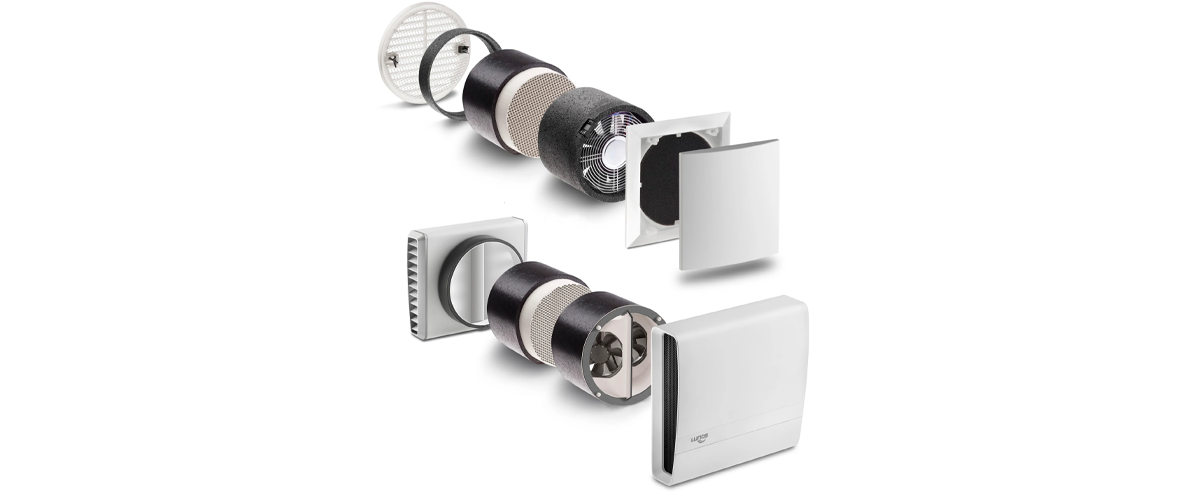Lunos HRV systems are a great way to add healthy, balanced and efficient ventilation to your project. For cold climate ventilation we offer three primary products: the Lunos e² and Lunos eGO. Each are through-wall paired fan units with regenerative heat recovery cores. These are the simplest - and often the most affordable - way of achieving continuous ventilation and good indoor air quality in airtight homes and multi-family residential units.
Q: Where do I start? A: We offer many great technical resources on our website to help you specify, size, install and operate these systems. Start with the product pages and scroll through the tabs. Here are a few of the best:
- Which Switch is Which? A Guide to Operating your Lunos System
- 475 Video: LUNOS e² Installation Guide
- Sizing Lunos e² through-wall ventilation units
Q: Where do I place Lunos e² fans?A: An e² fan should go in every enclosed living space - including bedrooms, living room, playroom, home office, etc. Rooms that are located between synchronized pairs will also be vented from the back and forth air movement.

Q: How is air transferred between rooms? A: It is recommended to undercut interior doors a minimum of 3/4" so that ventilation air can pass freely from room to room even if these doors are closed. If for acoustical or visual reasons doors cannot be undercut, air transfer devices should be integrated in walls or doors to allow for air to pass freely while reducing noise transfer between rooms.
Q: How many e² fans do I need? A: First, remember that e² systems operate (and are sold) in pairs. Each pair delivers up to 22 CFM. There are several ways to determine the optimal number of e² fans. Rooms and apartments under 1000 SF might only need one e² pair. Small homes might need 2-3 pairs, or more depending on area, ceiling height and # of bedrooms.
- Estimate: Measure the interior area (from drywall). A rough number is one e² pair for every 600-800 SF of living space.
- Formula (from ASHRAE 62 2010):
- Step 1: Divide the interior area by 100.
- Step 2: Add 1 to # of bedrooms, then multiply by 7.5.
- Step 3: Add Steps 1 & 2 for total CFM.
- Step 4: Divide by 20 CFM to calculate number of fans
- Example: 1,600 SF with 2 bedrooms = (1,600/100) + (3 x 7.5) = 16 + 22.5 cf = 38.5 CFM --> 2 e² pairs (See more examples here).

Q: How high on the wall should the fans go? A: Fans can go just about anywhere there is room, but it's best to put them higher up on the wall to avoid being blocked by furniture. Also make sure to keep them at least 12" away from ceilings and corners.
Q: Can I install fans in the ceiling? A: No. Lunos e² and eGO fans can only be installed horizontally in walls (at a slight tilt to ensure outward drainage).
Q: Are these HRVs or ERVs? A: Lunos systems in cold weather transfer 20-30% of the moisture back to the interior during each cycle. Since this is less than ducted ERVs which can transfer 50-60% moisture, we put them in the HRV category.
Q: How to choose between short and standard fans? A: First, measure your wall thickness from the inside of the drywall to the outside of the cladding.
- If your wall is greater than 12", use standard fans
- If your wall is less than 12", use short fans
- If your wall is less than 7.9", use short fans and cut the installation tube no shorter than 7.9" and box out your wall inward to make up the difference in thickness

Q: How to I install tubes airtight to my air barrier? A: Our ROFLEX 150 EPDM rubber gaskets fit snugly around the tubes, and are easily taped with TESCON Vana to any airtight layer (eg your airtight WRB, taped sheathing, INTELLO Plus, etc). This is the optimal route to perfect, flexible airtightness. ROFLEX are available individually or as kits containing a pair of gaskets and eight strips of Vana tape for taping all edges.
Q: How should the interior cover be installed? A: The interior cover plate has four small plastic tabs that attach to the cover insert. The plate can be inserted two ways. When used for Lunos operation, make sure that full insertion leaves a 1/2" gap on all four sides for ventilation air to move freely in and out. If you want to turn off the Lunos and close the cover (eg when going on vacation), carefully pull the cover out of the inserts, rotate 180 degrees, and reinsert fully.
Q: How should I ventilate bathrooms? A: For best practice we recommend installing a Lunos eGO in the bathroom for a fully balanced system with heat recovery. The eGO can be boosted to 12 CFM (balanced) or 27 CFM (exhaust-only) as needed.
Another common approach is to install a standard exhaust-only ceiling fan (or through-wall Lunos RA 15-60). Such a system is ideally on a timer or limited by a sensor to avoid unbalancing the building longer than needed.
Q: What about kitchens? A: The Lunos eGO is a great way to maintain your kitchen IAQ 24-7, with the option to boost the CFM to remove odors. The eGO is often used in conjunction with recirculating range hoods for projects that want to avoid direct vent range hoods.
Q: How long does summer ventilation mode stay on for? A: After 8 hours this function is automatically deactivated and the normal reversing time
(approx. 70 seconds) is restored.



